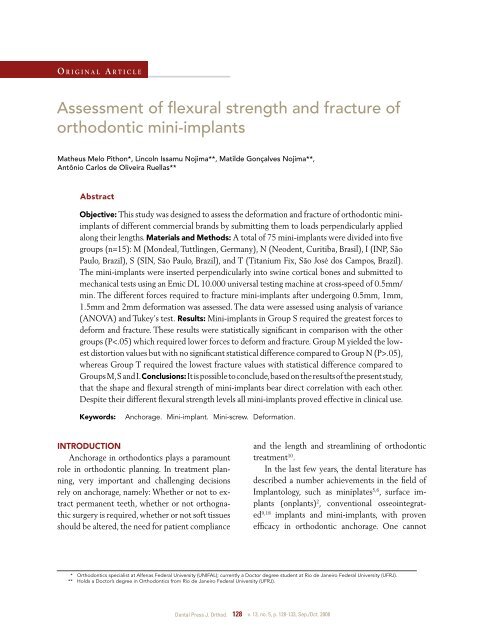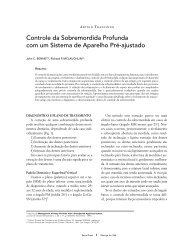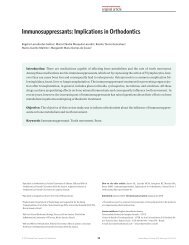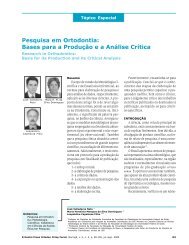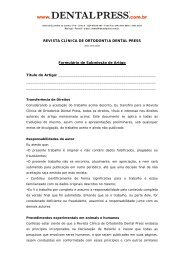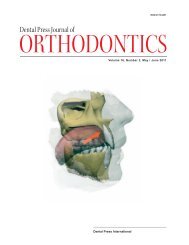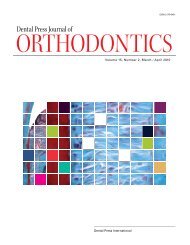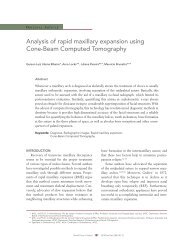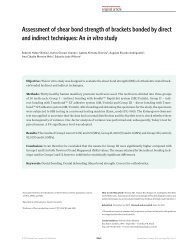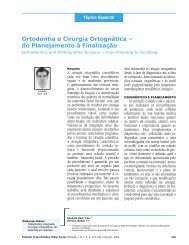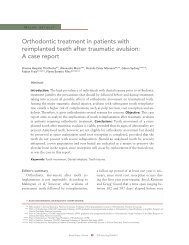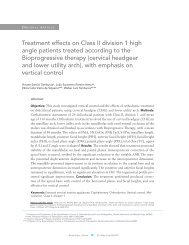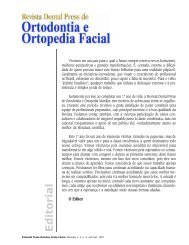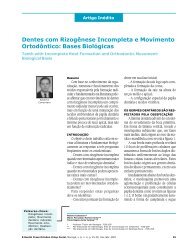Assessment of flexural strength and fracture of ... - Dental Press
Assessment of flexural strength and fracture of ... - Dental Press
Assessment of flexural strength and fracture of ... - Dental Press
Create successful ePaper yourself
Turn your PDF publications into a flip-book with our unique Google optimized e-Paper software.
PITHON, M. M.; NOJIMA, L. I.; NOJIMA, M. G.; RUELLAS, A. C. O.help but note, however, that mini-implants havearoused greater interest than other devices in thelast years 15 .The use <strong>of</strong> mini-implants ushers in a new conceptin Orthodontic Anchorage, named skeletalanchorage, which prevents any movement fromoccurring in the response unit. This is due to thefact that the anchorage unit is unable to movewhen submitted to orthodontic mechanics 4,12,14,20 .As is the case with conventional dental implantsystems, pr<strong>of</strong>essionals inserting a mini-implantshould take special care, both during surgery<strong>and</strong> in the stages where orthodontic forces are applied,in order to avert mini-implant deformationor even <strong>fracture</strong> 3,8 .Thanks to a reduction in mini-implant size,today a wider range <strong>of</strong> insertion sites is availablewhich helps to mitigate the risk <strong>of</strong> root injury. Thedown side, however, is that reduced size entails adecrease in the mini-screw’s <strong>flexural</strong> <strong>strength</strong>. Asa result, the maximum force required to permanentlydeform <strong>and</strong> <strong>fracture</strong> mini-implants is alsodiminished 8 .Based on this premise, the present study wasdesigned to assess the deformation <strong>and</strong> <strong>fracture</strong> <strong>of</strong>orthodontic mini-implants <strong>of</strong> different commercialbr<strong>and</strong>s by submitting them to loads perpendicularlyapplied along their lengths.MATERIALS AND METHODSAltogether, 75 mini-implants were used from5 different manufacturers <strong>and</strong> distributed into 5different groups, as shown in Box 1.Prior to use, the mini-screws had their dimensionsgauged under a pr<strong>of</strong>ile projector (Nikon,Tokyo, Japan) <strong>and</strong> were subsequently submittedto a JEOL scanning microscope (2000 FX, Tokyo,Japan) with a 15x magnification for morphologicalassessment. The purpose was to correlate thevalues found in the mechanical tests 7 with themini-implants’ morphology.To aid in carrying out the flexure <strong>strength</strong><strong>and</strong> <strong>fracture</strong> trials, specimens – with 8mm thickness- were fashioned from swine cortical bonesobtained from the mid-segment <strong>of</strong> a pig’s femurbone, which would serve as the mini-implants’ insertionsites.After the pig’s femur bones had been obtainedthey were dissected <strong>and</strong> sliced into bone blockswith 10cm cortical length <strong>and</strong> 8mm corticalthickness. The bone blocks were placed into PVCtubes (Tigre, Joinvile, Santa Catarina, Brazil) <strong>and</strong>bonded to these tubes using self-curing acrylicresin (Clássico, São Paulo, Brazil). To help in properlypositioning the bone blocks a glass square wasutilized to align the bone surface perpendicularlyto the ground.The specimens were then dipped into a salinesolution <strong>and</strong> kept in a fridge at a temperature <strong>of</strong> 8ºC. After 7 days had elapsed, the specimens wereremoved from the fridge <strong>and</strong> left sitting for 12hours at room temperature awaiting mini-screwinsertion.To insert the mini-implants a manual key wasattached to a parallelometer (Humpa, Rio de Janeiro,Brazil), whereby insertion could be madeparallel to the ground <strong>and</strong> perpendicular to thebone tissue.Groups Commercial br<strong>and</strong>s n Diameter (mm) Length (mm) Type AlloyM Mondeal 15 1,5 7N Neodent 15 1,6 7Self-drillingS SIN 15 1,6 6 Ti-6AL-4VI INP 15 1,5 6T Titanium Fix 15 1,5 5 Self-tappingBox 1 - Sample distribution with their respective diameters, lengths <strong>and</strong> alloy.<strong>Dental</strong> <strong>Press</strong> J. Orthod. 129 v. 13, no. 5, p. 128-133, Sep./Oct. 2008
<strong>Assessment</strong> <strong>of</strong> <strong>flexural</strong> <strong>strength</strong> <strong>and</strong> <strong>fracture</strong> <strong>of</strong> orthodontic mini-implantsImmediately following mini-screw insertion,the specimens were tested in the universal testingdevice (Fig. 1). In order to stabilize the specimensa vise-like device was contrived to keep the specimenssteady throughout the trials.The <strong>flexural</strong> <strong>strength</strong> test was conducted usingan Emic DL 10.000 universal testing machine(São José dos Pinhais, Paraná, Brazil) operating ata cross-head speed <strong>of</strong> 0.5mm/min through an activechisel head (Fig. 2). The force was applied tothe screw heads with the aim <strong>of</strong> deforming themini-screws by 0.5, 1.0, 1.5 <strong>and</strong> 2.0mm <strong>and</strong> to thepoint <strong>of</strong> <strong>fracture</strong> (Fig. 2).Statistical analyses were conducted with theaid <strong>of</strong> the SPSS 13.0 s<strong>of</strong>tware program (SPSS Inc.,Chicago, Illinois). A descriptive statistical analysis,including mean, st<strong>and</strong>ard deviation, median,minimum <strong>and</strong> maximum values, was performedfor the five groups under evaluation. The valuesfor maximum deformation <strong>and</strong> <strong>fracture</strong> forces (inN/cm²) were submitted to an analysis <strong>of</strong> variance(ANOVA) to determine whether there were anystatistical differences between the groups, <strong>and</strong>subsequently to Tukey’s test (Tab. 1).RESULTSThe results have shown deformation in allmini-implants. Group S mini-implants required,on average, greater forces to undergo deformation.The lowest deformation values were achieved byGroup M <strong>and</strong> Group N mini-screws.After mini-implants had been deformed by2mm, the same speed was maintained until <strong>fracture</strong>occurred, whereupon this maximum valuewas noted.Groups I <strong>and</strong> T showed less deformation thanthe other groups whereas <strong>fracture</strong> occurred priorto 2mm deformation (Tab. 1).FIGURE 1 - Flexure <strong>strength</strong> trial using an Emic DL 10.000 universal testing machine.FIGURE 2 - A mini-implant undergoing deformation during mechanical testing.<strong>Dental</strong> <strong>Press</strong> J. Orthod. 130 v. 13, no. 5, p. 128-133, Sep./Oct. 2008
PITHON, M. M.; NOJIMA, L. I.; NOJIMA, M. G.; RUELLAS, A. C. O.Table 1 - Mean <strong>and</strong> st<strong>and</strong>ard deviation values <strong>of</strong> forces required to deform mini-implants, <strong>and</strong> statistical analysis.Deformation (mm)Groups0,5mm sig.* 1,0mm sig.* 1,5mm sig.* 2,0mm sig.*M 44,54 ± 6,63 A 72,44 ± 9,63 A 87,75 ± 6,61 A 109,06 ± 2,86 AN 50,46 ± 6,45 A 74,33 ± 7,34 AD 87,83 ± 10,95 A 100,76 ± 8,89 AS 60,89 ± 8,31 B 183,31 ± 9,85 B 344,41 ± 8,44 B 326,35 ± 9,80 BI 82,71 ± 7,56 C 142,89 ± 7,60 C 165,48 ± 5,37 C -------T 55,04 ± 2,75 AB 90,90 ± 9,71 D 107,03 ± 9,47 D -------* Identical letters st<strong>and</strong> for no statistical differences (p > 0,05).Table 2 - Mean <strong>and</strong> st<strong>and</strong>ard deviation values <strong>of</strong> forces requiredto <strong>fracture</strong> mini-implants, <strong>and</strong> statistical analysis.Groups Fracture sig.* Deformation sig.*M 261,14 ± 10,74 A 3,48 ± 0,25 AN 119,52 ± 8,06 B 2,84 ± 0,30 ACS 476,06 ± 11,19 C 2,56 ± 1,07 ABCI 174,15 ± 7,81 D 1,59 ± 0,30 BCT 117,59 ± 10,50 B 1,94 ± 0,49 B* Identical letters st<strong>and</strong> for no statistical differences (p > 0,05).Ins<strong>of</strong>ar as <strong>fracture</strong> force values are concerned,Group S mini-implants had a statistically superiorperformance compared with the others, followedby Group M. The lowest values were recorded forGroups T <strong>and</strong> N, between which there were nostatistical differences. Group M required greaterdegree <strong>of</strong> deformation before fracturing, followedby Groups N <strong>and</strong> S, respectively. Conversely,Groups I <strong>and</strong> T <strong>fracture</strong>d prior to reaching the2mm deformation benchmark proposed in thisstudy (Tab. 2).DISCUSSIONKnowledge about the deformation <strong>of</strong> orthodonticanchorage structures is crucial in assessingpotential anchorage failure 7,11 . Based on thispremise, this study was designed to assess the<strong>strength</strong> required to deform orthodontic miniscrews<strong>and</strong> the <strong>strength</strong> required to <strong>fracture</strong> thesemini-screws when submitted to <strong>flexural</strong> load.The need to evaluate mini-implant deforma-tion when applying perpendicular force stemsfrom the fact that this axis is predominantly usedwhen applying mini-implant assisted orthodonticforces. To this end, specimens were fashionedwhich allowed mini-implants to be placed parallelto the ground, thereby enabling the application <strong>of</strong>perpendicular forced to their axes, as is the case inthe oral cavity.All mini-implants tested suffered deformationfrom the onset <strong>of</strong> force application to the moment<strong>of</strong> <strong>fracture</strong>. Group S required greater forcesthan any other group before deforming <strong>and</strong> fracturing(P0.05). These results can be ascribedto a larger diameter <strong>of</strong> the transmucosal region/screw thread junction <strong>of</strong> Group S mini-implantsversus a smaller diameter in Group M <strong>and</strong> GroupN, whose mini-implant heads <strong>and</strong> screw threadswere slightly disproportionate, which made themini-implants more prone to deformation evenwith lower forces.In light <strong>of</strong> the findings <strong>of</strong> this study, the term‘rigid anchorage’, as employed by Park et al. 16 ,should be reconsidered since it conveys the wrongidea that absolute resistance to orthodontic movementsis possible. This is corroborated by Liou etal. 13 , who also found anchorage loss when usingorthodontic mini-implants. This author reportsthat such drift could be attributed to differentfactors, such as mini-screw size, bone quality, osseointegrationtime <strong>and</strong> magnitude <strong>of</strong> the orthodonticforce.<strong>Dental</strong> <strong>Press</strong> J. Orthod. 131 v. 13, no. 5, p. 128-133, Sep./Oct. 2008


